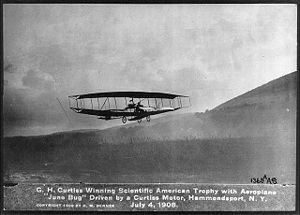AEA June Bug - Picture
More Aviation History

|
|
AEA June Bug
AEA June Bug

Role: Early experimental aircraft
Manufacturer: Aerial Experiment Association
Designed by: Glenn Curtiss
First flight: 1908-05-21
Status: Crashed 1909-01-02
Primary user: Aerial Experiment Association
Produced: 1908
Number built: 1
The June Bug (or Aerodrome #3) was an early US aircraft designed and flown by Glenn H. Curtiss and built by the Aerial Experiment Association (A.E.A) in 1908. The June Bug is famous for winning the first aeronautical prize ever awarded in the United States. A solid silver sculpted trophy, and $25,000 in cash, would be awarded to whoever made the first public flight of over 1 kilometer (3,280 ft). Glenn Curtiss had a hobby of collecting trophies, and he and the Aerial Experiment Association built the June Bug with hopes of winning the Scientific American Cup.
Aerodrome #3 included the previously used aileron steering system, but a shoulder yoke made it possible for the pilot to steer by leaning from side to side. The term aileron is believed to have been coined when describing the June Bug. The varnish that sealed the wing fabric cracked in the heat, and so a mixture of turpentine, paraffin, and gasoline, later to be known as wing dope, was created. The June Bug had yellow wings because yellow ochre was added to the wing mixture in order to make the aircraft show up better in photographs.
It was named by Dr. Alexander Graham Bell after the common Phyllophaga, a beetle known colloquially in North America as the "June bug," because June bugs were observed to fly similarly to aircraft: they have large stiff outer wings for gliding, and more delicate smaller propeller-like wings that do the actual propulsion.
The June Bug was tested in Hammondsport, New York at Stony Brook Farm. Curtiss flew it successfully three times out of four tries on June 21, 1908, with distances of 456 ft (139 m), 417 ft, and 1,266 ft (386 m) at 34.5 mph (55.5 km/h). On June 25, performances of 2,175 ft (663 m) and 3,420 ft (1,040 m) were so encouraging that the Association contacted the Aero Club of America about trying for the Scientific American Cup.
The Aero Club contacted the Wright brothers, offering them the chance to make an attempt first. Orville wrote to decline the opportunity on June 30, as the Wrights were busy completing their deal with the United States Government. The message was received by July 1, and Curtiss took to the air as requested on July 4, Independence Day.
The flight was a great public event, bringing people in from all directions. The event was overseen by a delegation of 22 notable members of the Aero Club, headed by Alan R. Hawley. Families came as early as 5:00am to claim a spot on the grassy hill, along with reporters, photographers, and a motion picture film crew. Consequently, the June Bug became the first airplane in the United States to perform in a movie. A thunderstorm began,and umbrellas popped up around the hillside. The town of Hammondsport was nearly empty as everyone was watching the event. The nearby Pleasant Valley Wine Company very generously opened its doors and offered generous free samples to all who were there. Charles Manly, who had unsuccessfully tested the Langley Aerodrome in 1903, measured out the 1 km and 20 ft (6.1 m) distance with plenty of volunteer help. The June Bug took one false start, going 40 feet (12 m) high, but not far enough. On the second try, the airplane successfully flew 5,360 ft (1.6 km) in 1 minute 40 seconds, winning the trophy and a US$25,000 cash prize. It was such an amazing sight that one woman watching actually was hit by a train on nearby tracks and suffered two broken ribs. After the flight, the wine cellars reopened their doors with free champagne for all.
Amidst the publicity following the flight, the Wrights sent a warning to Curtiss that they had not given permission for the use of "their" aircraft control system to be used "for exhibitions or in a commercial way". In fact, none of the AEA's aircraft used a wing-warping system like the Wrights' for control, relying instead on triangular ailerons designed by Alexander Graham Bell, which he successfully patented in December 1911. However, in 1913 a court ruled that this technique was an infringement of the Wright's 1906 patent. Three years previous to the June Bug's flight, the Wrights had made flights of up to 24 miles (38 km) without official witnesses. Also, the Wrights would have been required to install wheels and dispense with a catapult launch to compete for the 1908 prize.
From October to November, the June Bug was modified by adding floats to it in an attempt to create a seaplane. Renamed Loon, attempts to fly it began on Keuka Lake on November 28. Although the aircraft could achieve speeds of up to 29 mph (43 km/h) on the water, it could not take off, and on January 2, 1909 one of the floats filled with water, and the Loon unexpectedly sank. When it was recovered, it finally rotted away in a nearby boathouse.
Specifications (June Bug)
General characteristics
Crew: 1
Length: 27 ft 6 in (8.38 m)
Wingspan: 42 ft 6 in (13.0 m)
Height: ()
Powerplant: 1x— Curtiss air-cooled V8 engine, 40 hp (30 kW)
Performance
Maximum speed: 39 mph (34 knots, 62 km/h)
Range: 5,360 ft (1,630 m)
Squier, George Owen (1908). "The Present Status of Military Aeronautics. II. Aviation. Representative Aeroplanes Of Various Types. The June Bug.". Annual Report of the Board of Regents of the Smithsonian Institution: 135-136 (Also Plate 23, Fig. 2). http://books.google.com/?id=gtQWAAAAYAAJ&pg=PA135. Retrieved 2009-08-07.
"Aerofiles". http://www.aerofiles.com/_ab.html. Retrieved 2005-05-19.
Related development
Curtiss Golden Flyer
More airplanes.
Source: WikiPedia